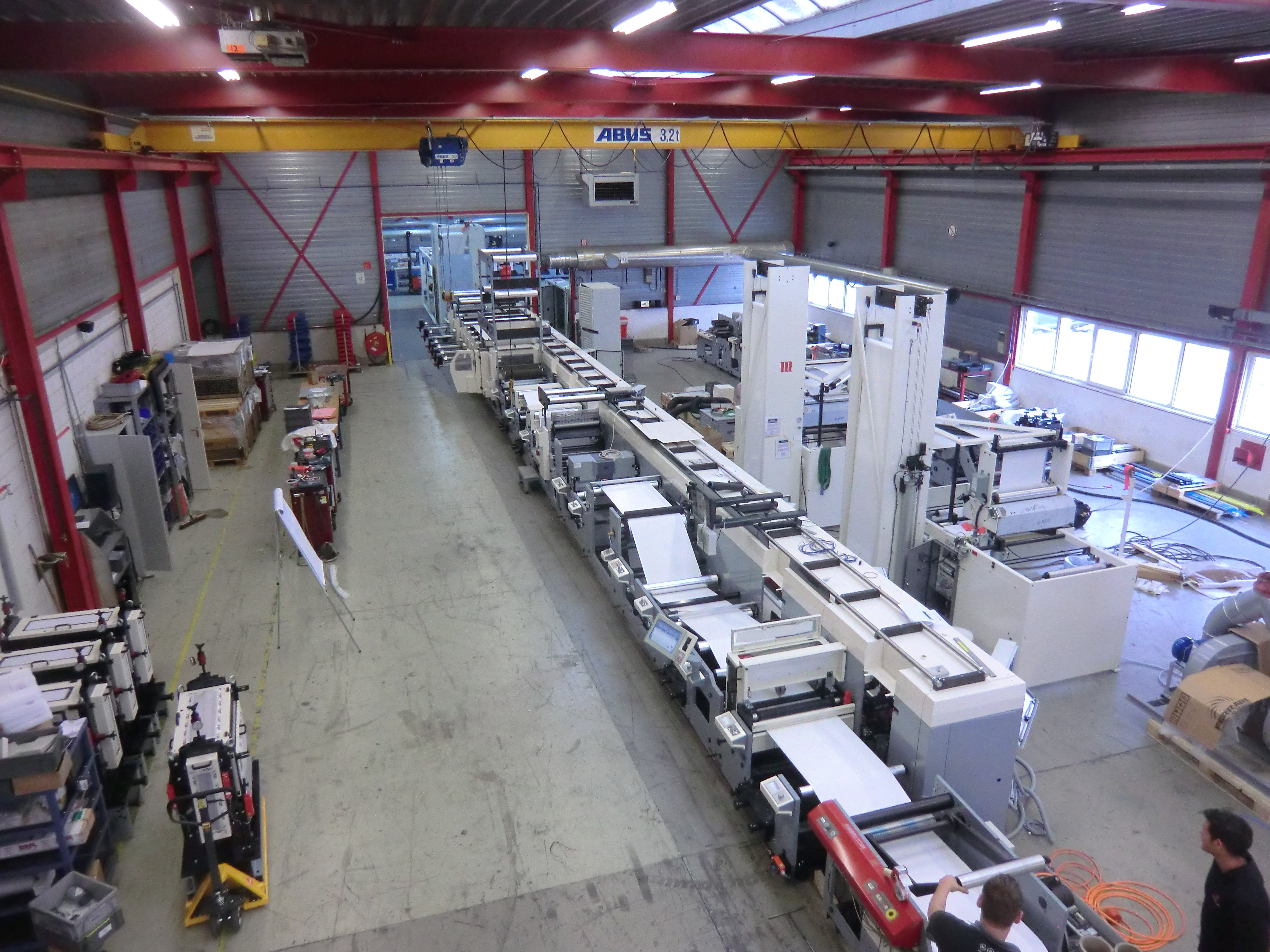Being in the business for 25+ years, our engineers spend a great portion of time keeping MPS machines at the forefront of technology.
At the same time, we welcome challenges to stay hungry, eager & excited!
That’s why we’re keen to take on new projects combining different printing & converting technologies – and help them evolve into one complex flexo or hybrid printing machine.
MPS presses for special applications
In recent years, MPS has designed and delivered several specialized machines designed not only with reliable and well-known MPS flexo stations, but combined with (security) offset, gravure, (in-register) cold foiling and (flatbed) hot foiling, integrated silk screen printing, in-register hotmelt, several die & punch applications, digital variable data printing and the digital platform.
The finishing touch – or cherry on top - is adding the ability to produce multi-layer (peel & reseal) labels.
 the largest press ever built by MPS; a 36 metres / 118 ft long EXL-Packaging combination press. Click hereto watch a video of this press.
the largest press ever built by MPS; a 36 metres / 118 ft long EXL-Packaging combination press. Click hereto watch a video of this press.
What do all these projects have in common? A to Z Project Management!
A multidisciplinary approach
During the pre–order phase, we try to not reinvent the wheel.
At MPS, we design and build top-quality and reliable printing machines, and form strategic partnerships with suppliers who offer complementary printing technologies. Working together, we can develop very special machines that combine MPS printing expertise with specialized converting, such as customized drying, patterned hot melt unit, customized applications, die cutting, sheeting & stacking and more.
A multidisciplinary approach to bringing in partner expertise from the beginning is key to a successful and timely delivery of a project, and within budget. As a project manager, we stay in close contact with the customer and/or end-user (which is often not the same party) and ensure all the stakeholders play their part.
Since these projects are not ‘just a label machine’, end-to-end project management becomes increasingly important. From when the project begins on the drawing board during the quotation phase - to the final machine Site Acceptance Test at the customer site - the project manager is involved at every step. Sometimes we’re a technical counsellor, other times an accountant, but always with the end customer in mind.
Production of a non-standard machine
When the order of a specialized machine is released within MPS, experienced mechanical & software engineers and if required, R&D staff will be involved.
A kick-off meeting takes place including all relevant technology suppliers where the basic project schedule is made. From there, the complete process is monitored and controlled using periodic technical review & progress meetings, and always with the needs and wishes of the customer.

When the engineering phase has ended and all parts are ordered, another milestone is reached when initial assembly of the machines begins.
In this phase, where all the parts are put together in separate modules and later become one machine, actively monitoring the delivered goods by applying 100% quality control on all the newly engineered parts, and sampling tests on general parts as well, is vital.
It’s during the next stage of final assembly where communication with the customer becomes very exciting! This is when all the individual modules are assembled together and you witness the machine being born. Regular customer updates now include pictures as the machine evolves.


Building a printing press is like building a house
After assembly, the machine is brought to life during the commissioning phase.
Once final mechanical & electrical checks are made, power to the machine is switched on and the software engineers start doing their magic. Modern servo-driven flexo presses are computer controlled - even a (simple) PLC will not do anymore. The numerous tasks the brain of the machine must perform require stronger computers, faster internal communication and state-of-the-art equipment.
People often ask why it takes so long to release a machine after assembly is completed.
I explain by comparing it to building a new house. When the framework is built, and the roof, windows and doors are installed, it roughly takes the same amount of time to finish the inside structure. Even though you can’t visually see much happening from the outside, there’s a lot of work still to do on the inside.
Machine functionality tests are a very important part of machine commissioning. All the printing & converting options need to be thoroughly tested to ensure a fully optimized machine.
Factory Acceptance Test (FAT) and installation at customer site
Factory acceptance is a major milestone for both the customer and press manufacturer, however at the same time is usually not a difficult milestone. At this point, the machine is working according to specifications, and we demonstrate its complete functionality. That’s it…a happy customer!
Another area where good project management is required is when the machine is installed at the customer site and several other parties come into the equation. This is when thorough preparation is key.
MPS Project Managers visit the site at least once before the machine arrives to discuss the specific requirements, and return onsite again if needed. Installing a (custom-made) machine is not rocket science, however machine manufacturers have the experience and can help customers prepare to avoid delays.
The site acceptance test (SAT) is usually a repeat of the FAT, however it now takes place in the final production environment, preferably with the operators participating as well. In my opinion, training begins when power to the machine is switched on!
At MPS, we take project management very seriously, especially for non-standard machines.
Would you like to know more about a custom-made flexo or hybrid press? We’re happy to discuss! Click here to contact us.
Visit us at Labelexpo Europe 2019 to see what special applications are being made with MPS presses!